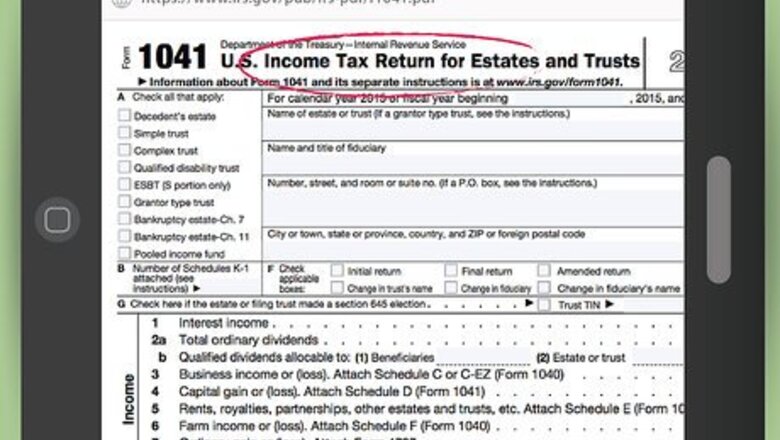
views
Understanding When to Apply for an EIN
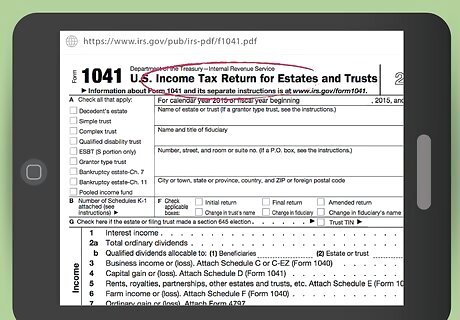
Apply for an EIN if you need one to report estate income on IRS Form 1041. This is the most common reason to apply for an EIN for an estate. If the decedent had income-generating assets, such as savings accounts, stocks, bonds, mutual funds, or rental property, you will likely have to fill out IRS Form 1041, which is an income tax return for the estate. This form must be completed if the estate's assets generate more than $600 in annual gross income.
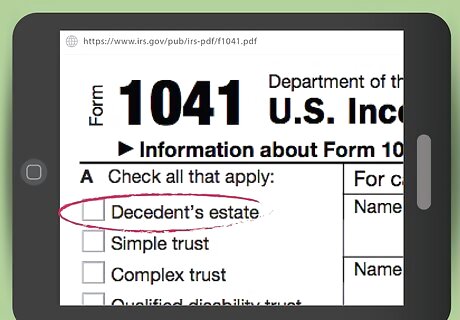
Apply for an additional EIN if a trust will be created with funds from the estate. If, for example, the decedent's will establishes some sort of trust—a legal relationship where one person holds property for the benefit of another person—out of the estate's funds, you will need to apply for a separate EIN for the trust. This trust is considered a different legal entity from the estate and therefore will need its own EIN.
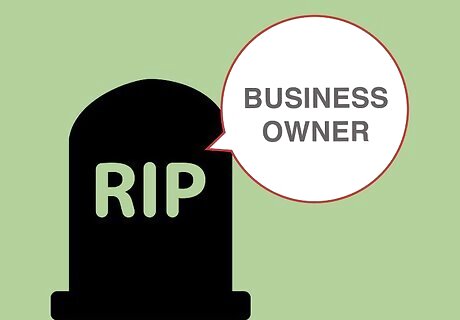
Apply for an additional EIN if the estate will operate a business after its owner's death. Another time you would need an additional EIN is for any business that funds from the estate will be used to operate following the death of the decedent. Just like any other business, this new business will need its own EIN.
Completing IRS Form SS-4
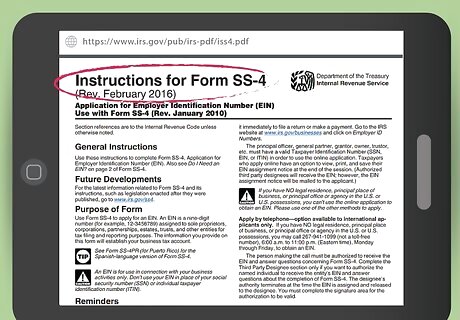
Obtain and read the instructions for IRS Form SS-4. Form SS-4, issued by the Internal Revenue Service, is required to apply for the EIN that will be used to complete Form 1041, which governs the income tax return for the estate. The instructions for this form are available online. Be sure to read them thoroughly, as the requirements for this form are not easy to understand at first glance.
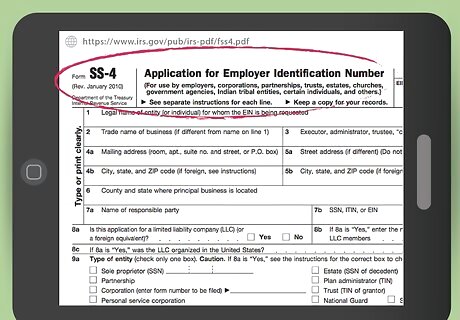
Obtain a copy of IRS Form SS-4. Once you have read the instructions, you will need an actual copy of the form. This form is available online through the IRS' website in PDF format. Print out a copy of this form and get ready to fill it out.
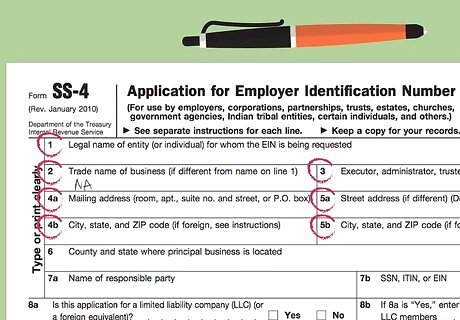
Complete Lines 1 through 6. This information in this section serves to identify the estate. Fill out the information as follows: In Line 1, enter the first name, middle initial, and last name of the decedent, followed by the word "Estate." In Line 2, write "N/A," which stands for non-applicable. In Line 3, enter the name (first name, middle initial, last name) of the executor, administrator, or any other fiduciary, as applicable. In Lines 4a–b, enter the mailing address of the estate. The IRS will use this address when sending any correspondence. Fill out Lines 5a–b only if the executor or administrator has an address different from that of the estate. In Line 6, enter the county and state where the will is probated. In Line 7a-b, Enter the full name (first name, middle initial, last name, if applicable) and SSN of the responsible party (executor, administrator, personal representative, or other fiduciary)
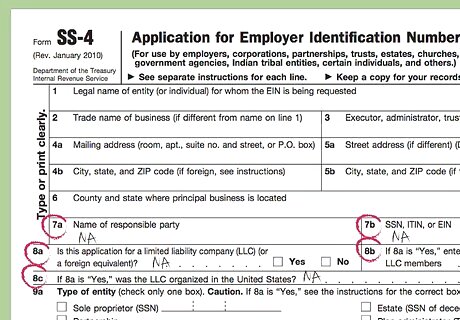
Write "N/A" in Lines 8a–c. This information is only used by certain companies completing this form, and does not apply to an estate's application for a tax identification number.
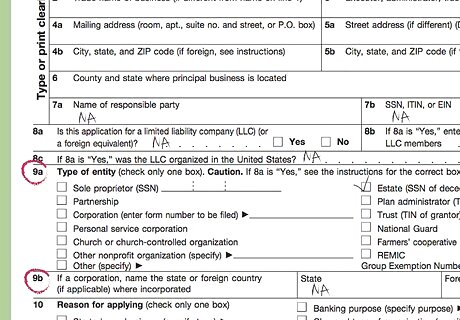
Check the box for "Estate" in Line 9a. This establishes that you are applying on behalf of an estate. You will also need to enter the social-security number of the decedent in the space provided. Write "N/A" in Line 9b. This only pertains to corporations using this form.
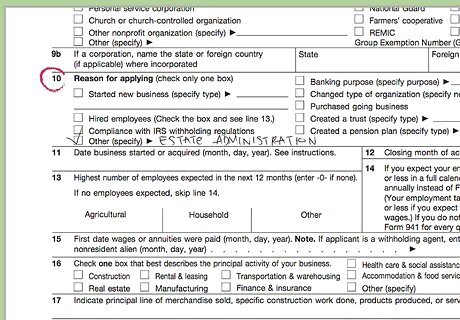
Check the box for "Other" in Line 10. This part of the form establishes your reason for applying for a tax identification number. After checking this box, you are asked to specify a reason. Enter "Estate Administration" in this space.
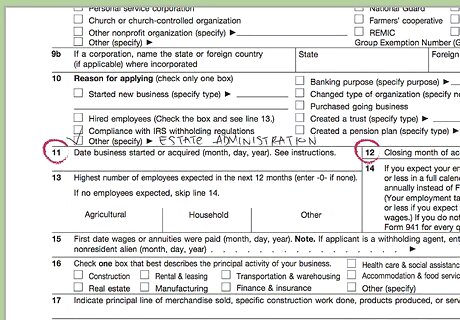
Complete Lines 11 and 12. This information will relate to dates that will be used in determining the estate's tax liability. On Line 11, enter the date the estate was funded (usually the date of the decedent's death), and on Line 12 enter the last month of your accounting/tax year.
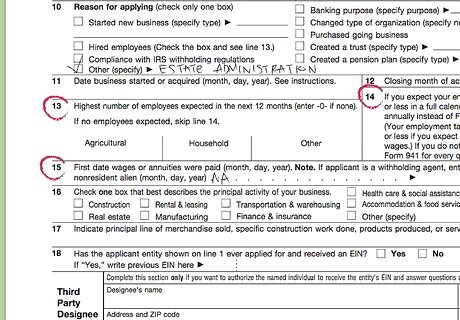
Complete Lines 13 through 15. This information pertains to any employees working for the estate. For instance, if the estate hired cooks, maids, gardeners, etc., you would need to fill out these sections as appropriate. Most likely the estate will not have employees, so if this is the case enter "0" in Line 13 and write in "N/A" on Lines 14 and 15.
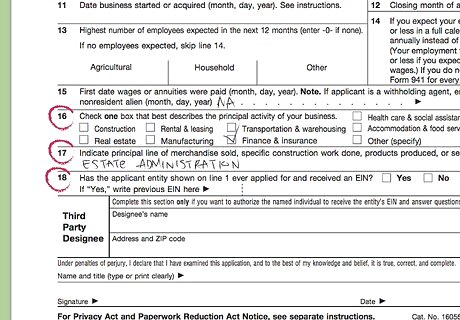
Complete Lines 16 through 18. This information again serves to identify that you are filling out this form on behalf of an estate. Fill out the information as follows: In Line 16, check the box for "Finance & Insurance." In Line 17, enter "Estate Administration." If the decedent has applied for and been issued an employment identification number in the past, check the box for "yes," and provide the previous number in the space provided. Otherwise, check the box for "no" and write "N/A" in the space provided.
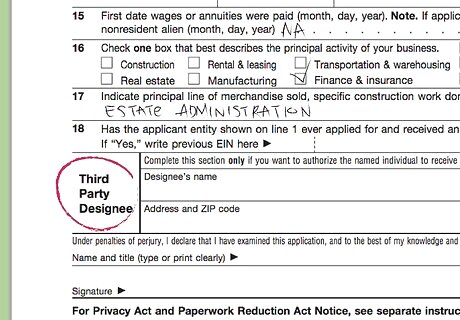
Complete the "Third Party Designee" section if applicable. Complete this portion of the form if you want to authorize the person named in this section to receive the employer identification number and be able to answer any questions that arise regarding how this form was filled out. Otherwise, write in "N/A" here. For instance, if you are completing this form and you wish your attorney to be the person to receive the identification number, you would put your attorney's contact information here.
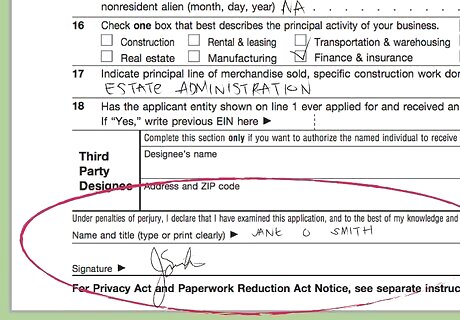
Sign and date the form in the space provided. Also be sure to print your name and title and write your telephone and/or fax number in the spaces provided.
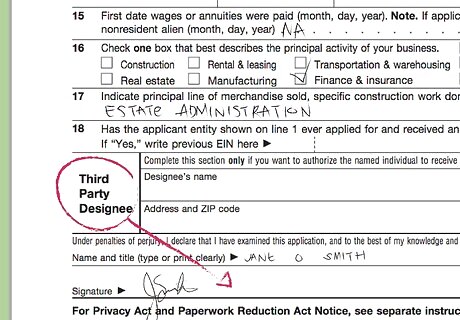
Have your third-party designee sign if necessary. If you have filled out the "Third Party Designee" section, you will want to make sure both you and that third party sign this form.
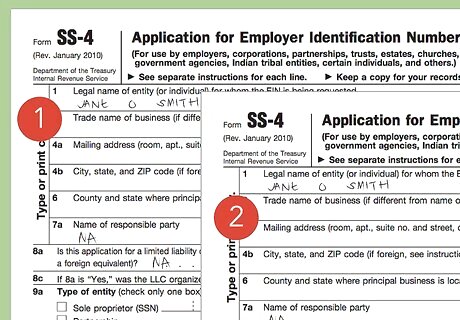
Make a copy of the form for your records. This is an important legal document and, as with all such documents, you should make a copy that you can reference later. Be sure to keep it in a secure location because it contains a lot of sensitive information.
Applying for an EIN
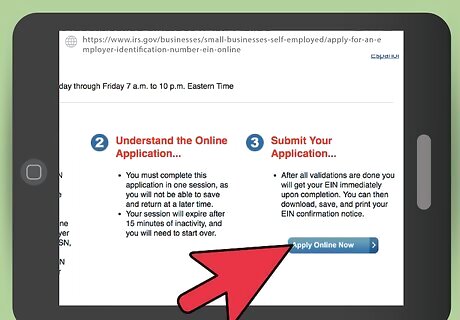
Apply online for a convenient option. The easiest way to obtain an EIN for the estate is to apply online on the IRS' website. Read the simple directions presented at the beginning, click the button to apply online and then, using the information you filled out in Form SS-4, answer the questions to receive your EIN. After your information is validated by the IRS, your EIN will be issued immediately. After you receive your EIN, be sure to save and print your EIN confirmation notice for your records. You can apply online Monday through Friday between 7:00 a.m. and 10:00 p.m. Eastern Time. You will not actually need to mail Form SS-4 to the IRS if you apply for the EIN online.
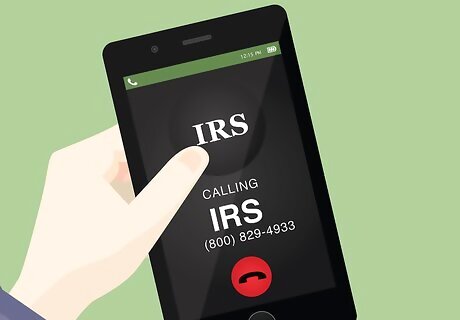
Apply by phone if you are an international taxpayer. You can only apply for an EIN over the phone if you are an international taxpayer. Have your Form SS-4 nearby, as the IRS representative to whom you will speak will need this information to process your request. Once your information is validated, you will be given an EIN immediately. Write it on the top of Form SS-4, sign, and date it. The phone number to use is (267) 941-1099 and you can reach the IRS between 6:00 a.m. and 11:00 p.m. Eastern Standard Time on Monday through Friday. You may be asked to mail a copy of Form SS-4 after receiving the EIN over the phone. If you are asked to do so, mail it to the address provided within 24 hours of your phone conversation. (Be sure to make a copy for yourself first.)
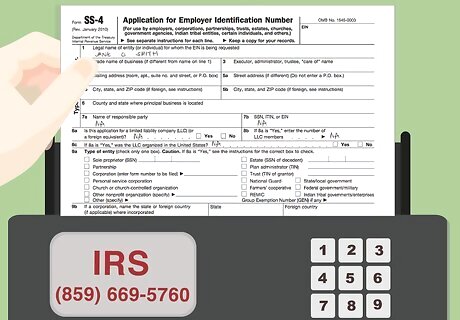
Apply by fax if it suits your needs. You can also apply for the estate's EIN via fax. Make sure your Form SS-4 is complete and accurate and that it contains your fax number so the IRS can send you a response. Then fax the form to (855) 641-6935 if you're in the U.S. or (304) 707-9471 if you're outside the U.S. You will receive the EIN by fax within 4 business days.
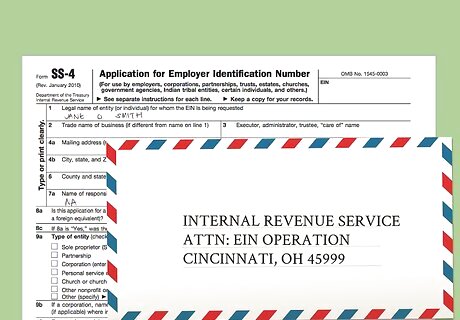
Apply by mail if you're not in a hurry. You also have the option to apply for the EIN by mail. Be aware, however, that this process is considerably longer than the others, as it takes about 4 weeks for the IRS to receive and process your request. As before, make sure your Form SS-4 is complete and accurate and send it by certified mail to the following address: Internal Revenue Service Attn: EIN Operation (if you're outside of the U.S., use "Attn: EIN International Operation") Cincinnati, OH 45999


















Comments
0 comment